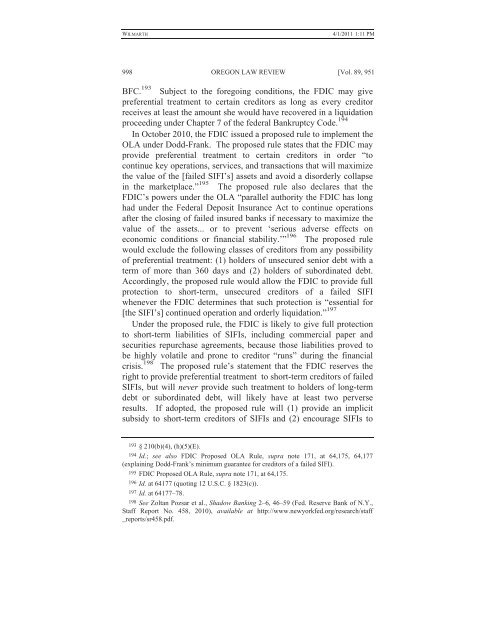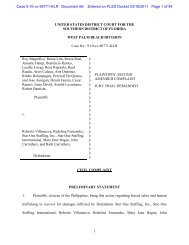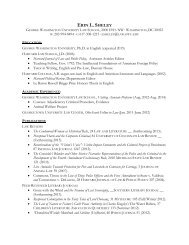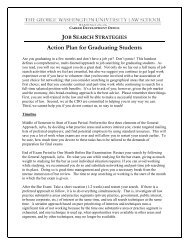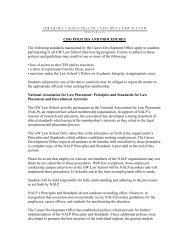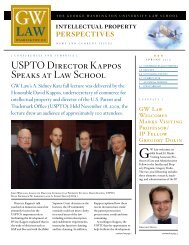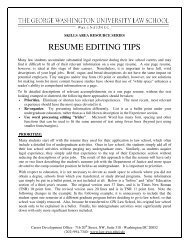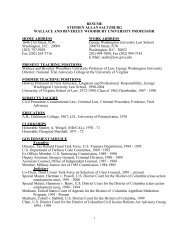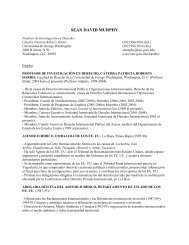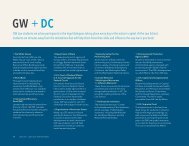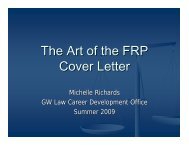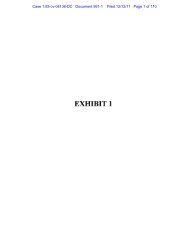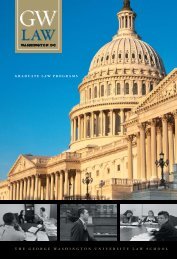CLE Materials for Panel #1 - George Washington University Law ...
CLE Materials for Panel #1 - George Washington University Law ...
CLE Materials for Panel #1 - George Washington University Law ...
Create successful ePaper yourself
Turn your PDF publications into a flip-book with our unique Google optimized e-Paper software.
WILMARTH<br />
4/1/2011 1:11 PM<br />
998 OREGON LAW REVIEW [Vol. 89, 951<br />
BFC. 193 Subject to the <strong>for</strong>egoing conditions, the FDIC may give<br />
preferential treatment to certain creditors as long as every creditor<br />
receives at least the amount she would have recovered in a liquidation<br />
proceeding under Chapter 7 of the federal Bankruptcy Code. 194<br />
In October 2010, the FDIC issued a proposed rule to implement the<br />
OLA under Dodd-Frank. The proposed rule states that the FDIC may<br />
provide preferential treatment to certain creditors in order “to<br />
continue key operations, services, and transactions that will maximize<br />
the value of the [failed SIFI’s] assets and avoid a disorderly collapse<br />
in the marketplace.” 195 The proposed rule also declares that the<br />
FDIC’s powers under the OLA “parallel authority the FDIC has long<br />
had under the Federal Deposit Insurance Act to continue operations<br />
after the closing of failed insured banks if necessary to maximize the<br />
value of the assets... or to prevent ‘serious adverse effects on<br />
economic conditions or financial stability.’” 196 The proposed rule<br />
would exclude the following classes of creditors from any possibility<br />
of preferential treatment: (1) holders of unsecured senior debt with a<br />
term of more than 360 days and (2) holders of subordinated debt.<br />
Accordingly, the proposed rule would allow the FDIC to provide full<br />
protection to short-term, unsecured creditors of a failed SIFI<br />
whenever the FDIC determines that such protection is “essential <strong>for</strong><br />
[the SIFI’s] continued operation and orderly liquidation.” 197<br />
Under the proposed rule, the FDIC is likely to give full protection<br />
to short-term liabilities of SIFIs, including commercial paper and<br />
securities repurchase agreements, because those liabilities proved to<br />
be highly volatile and prone to creditor “runs” during the financial<br />
crisis. 198 The proposed rule’s statement that the FDIC reserves the<br />
right to provide preferential treatment to short-term creditors of failed<br />
SIFIs, but will never provide such treatment to holders of long-term<br />
debt or subordinated debt, will likely have at least two perverse<br />
results. If adopted, the proposed rule will (1) provide an implicit<br />
subsidy to short-term creditors of SIFIs and (2) encourage SIFIs to<br />
193 § 210(b)(4), (h)(5)(E).<br />
194 Id.; see also FDIC Proposed OLA Rule, supra note 171, at 64,175, 64,177<br />
(explaining Dodd-Frank’s minimum guarantee <strong>for</strong> creditors of a failed SIFI).<br />
195 FDIC Proposed OLA Rule, supra note 171, at 64,175.<br />
196 Id. at 64177 (quoting 12 U.S.C. § 1823(c)).<br />
197 Id. at 64177–78.<br />
198 See Zoltan Pozsar et al., Shadow Banking 2–6, 46–59 (Fed. Reserve Bank of N.Y.,<br />
Staff Report No. 458, 2010), available at http://www.newyorkfed.org/research/staff<br />
_reports/sr458.pdf.


